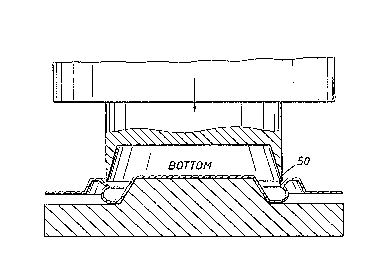Une partie des informations de ce site Web a été fournie par des sources externes. Le gouvernement du Canada n'assume aucune responsabilité concernant la précision, l'actualité ou la fiabilité des informations fournies par les sources externes. Les utilisateurs qui désirent employer cette information devraient consulter directement la source des informations. Le contenu fourni par les sources externes n'est pas assujetti aux exigences sur les langues officielles, la protection des renseignements personnels et l'accessibilité.
L'apparition de différences dans le texte et l'image des Revendications et de l'Abrégé dépend du moment auquel le document est publié. Les textes des Revendications et de l'Abrégé sont affichés :
| (12) Brevet: | (11) CA 1277183 |
|---|---|
| (21) Numéro de la demande: | 1277183 |
| (54) Titre français: | METHODE DE FACONNAGE D'UN RECIPIENT A LEVRE ROULEE |
| (54) Titre anglais: | METHOD FOR MAKING A ROLLED LIP CONTAINER |
| Statut: | Périmé et au-delà du délai pour l’annulation |
| (51) Classification internationale des brevets (CIB): |
|
|---|---|
| (72) Inventeurs : |
|
| (73) Titulaires : |
|
| (71) Demandeurs : |
|
| (74) Agent: | SWABEY OGILVY RENAULT |
| (74) Co-agent: | |
| (45) Délivré: | 1990-12-04 |
| (22) Date de dépôt: | 1986-10-27 |
| Licence disponible: | S.O. |
| Cédé au domaine public: | S.O. |
| (25) Langue des documents déposés: | Anglais |
| Traité de coopération en matière de brevets (PCT): | Non |
|---|
| (30) Données de priorité de la demande: | ||||||
|---|---|---|---|---|---|---|
|
METHOD FOR MAKING A ROLLED
LIP CONTAINER
Abstract of the Invention
A process for making a rigid packaging container which contains a
"rolled lip" which comprises deforming a sheet of metal, plastic or paper
composite material over a mold into a desired formed shape which contains a
"lip", advancing a trimming means from the convex or bottom side of the shape
while said shape is supported so that said shape does not deform; and trimming
the shape from the convex or bottom side of the shape at a point on the lip of
the shape which undercuts the periphery of the shape while, at the same time,
forcing open the undercut of the lip of the shape.
Note : Les revendications sont présentées dans la langue officielle dans laquelle elles ont été soumises.
Note : Les descriptions sont présentées dans la langue officielle dans laquelle elles ont été soumises.

2024-08-01 : Dans le cadre de la transition vers les Brevets de nouvelle génération (BNG), la base de données sur les brevets canadiens (BDBC) contient désormais un Historique d'événement plus détaillé, qui reproduit le Journal des événements de notre nouvelle solution interne.
Veuillez noter que les événements débutant par « Inactive : » se réfèrent à des événements qui ne sont plus utilisés dans notre nouvelle solution interne.
Pour une meilleure compréhension de l'état de la demande ou brevet qui figure sur cette page, la rubrique Mise en garde , et les descriptions de Brevet , Historique d'événement , Taxes périodiques et Historique des paiements devraient être consultées.
| Description | Date |
|---|---|
| Inactive : CIB désactivée | 2017-09-16 |
| Inactive : CIB du SCB | 2017-01-07 |
| Inactive : CIB expirée | 2017-01-01 |
| Inactive : Demande ad hoc documentée | 1996-12-04 |
| Le délai pour l'annulation est expiré | 1996-06-04 |
| Lettre envoyée | 1995-12-04 |
| Accordé par délivrance | 1990-12-04 |
Il n'y a pas d'historique d'abandonnement
Les titulaires actuels et antérieures au dossier sont affichés en ordre alphabétique.
| Titulaires actuels au dossier |
|---|
| SHELL INTERNATIONALE RESEARCH MAATSCHAPPIJ B.V. |
| SHELL OIL COMPANY |
| Titulaires antérieures au dossier |
|---|
| JOHN F., JR. BRADFORD |